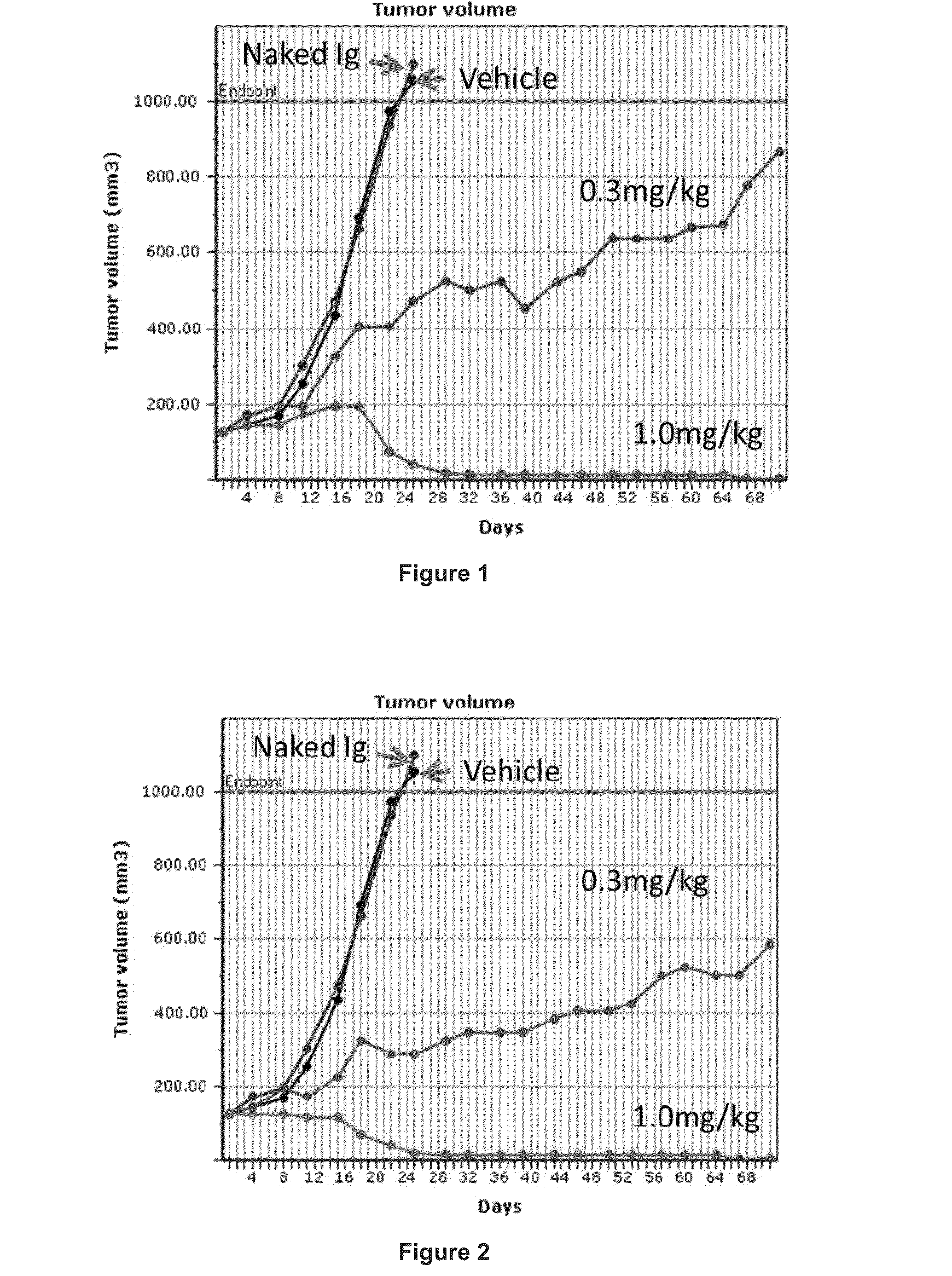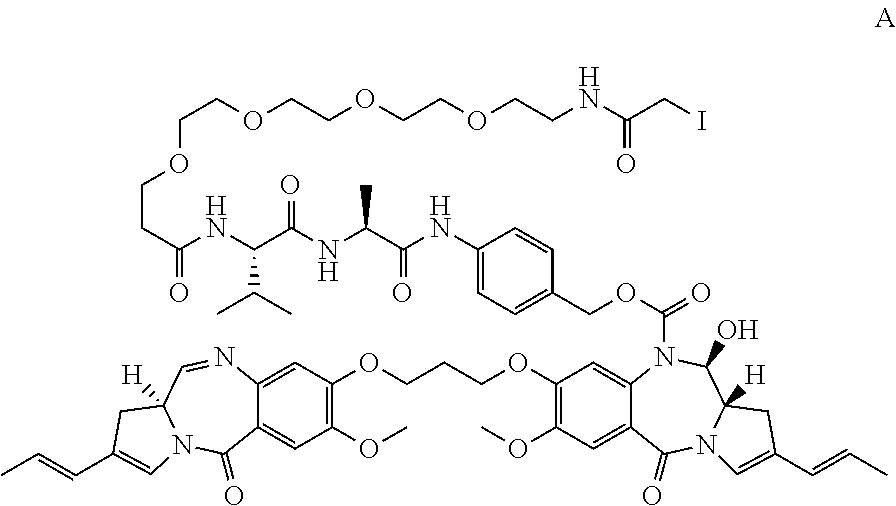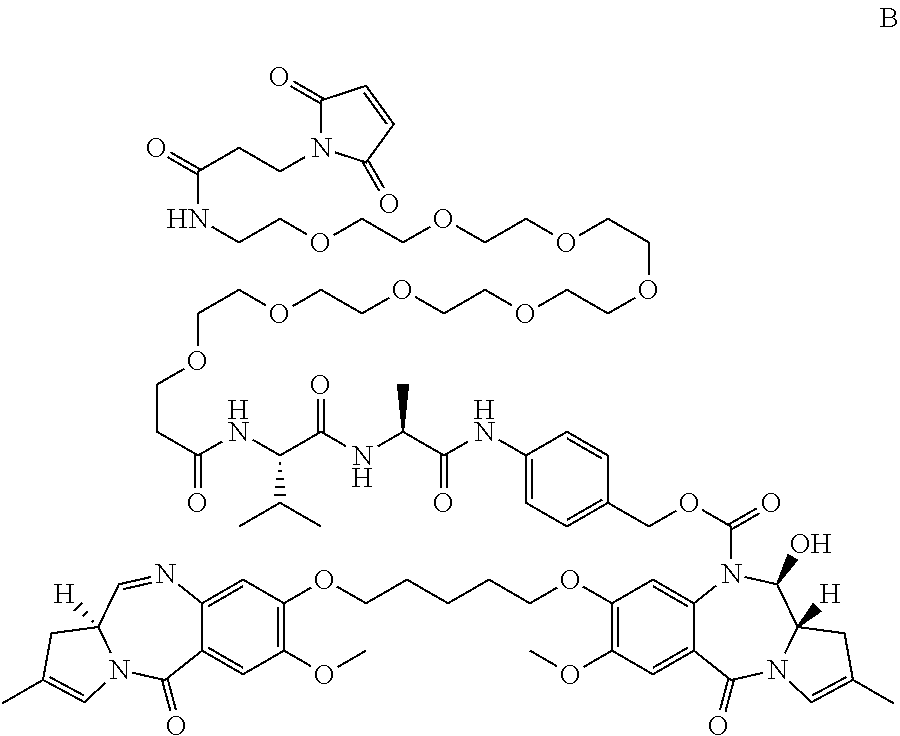Pyrrolobenzodiazepines and conjugates thereof
a technology which is applied in the field of pyrrolobenzodiazepines and conjugates thereof, can solve the problems of inacceptable levels of toxicity to normal cells, and achieve the effect of strong binding
- Summary
- Abstract
- Description
- Claims
- Application Information
AI Technical Summary
Benefits of technology
Problems solved by technology
Method used
Image
Examples
example 1
(i) (S)-(2-amino-5-methoxy-4-((triisopropylsilyl)oxy)phenyl)(2-(((tert-butyldimethylsilyl)oxy)methyl)-4-methyl-2,3-dihydro-1H-pyrrol-1-yl)methanone (9)
[0610]
(a) 5-methoxy-2-nitro-4-((triisopropylsilyl)oxy)benzaldehyde (2)
[0611]Neat triisopropylsilylchloride (56.4 mL, 262 mmol) was added to a mixture of imidazole (48.7 g, 715.23 mmol) and 4-hydroxy-5-methoxy-2-nitrobenzaldehyde 1 (47 g, 238 mmol) (ground together). The mixture was heated until the phenol and imidazole melted and went into solution (100° C.). The reaction mixture was allowed to stir for 15 minutes and was then allowed to cool, whereupon a solid was observed to form at the bottom of the flask (imidazole chloride). The reaction mixture was diluted with 5% EtOAc / hexanes and loaded directly onto silica gel and the pad was eluted with 5% EtOAc / hexanes, followed by 10% EtOAc / hexanes (due to the low excess, very little unreacted TIPSCI was found in the product). The desired product was eluted with 5% ethyl acetate in hexane....
example 2
[0636]
[0637]Compound 25 is compound 79 of WO 2011 / 130598
(11S)-4-(1-iodo-20-isopropyl-23-methyl-2,18,21-trioxo-6,9,12,15-tetraoxa-3,19,22-triazatetracosanamido)benzyl 11-hydroxy-7-methoxy-8-(3-((7-methoxy-5-oxo-2-((E)-prop-1-en-1-yl)-5,11a-dihydro-1H-benzo[e]pyrrolo[1,2-a][1,4]diazepin-8-yl)oxy)propoxy)-5-oxo-2-((E)-prop-1-en-1-yl)-11,11a-dihydro-1H-benzo[e]pyrrolo[1,2-a][1,4]diazepine-10(5H)-carboxylate (26)
[0638]N,N′-diisopropylcarbodiimide (DIC, 4.71 μL, 0.0304 mmol) was added to a solution of amine 25 (0.0276 mmol) and lodo-(PEG)4-acid (13.1 mg, 0.0304 mmol) in dry dichloromethane (0.8 mL). The reaction was stirred for 3 hours and the presence of starting material was no longer observed by LC / MS. The reaction mixture was directly loaded onto a thin-layer chromatography (TLC) plate and purified by prep-TLC (10% methanol in chloroform). Pure bands were scraped off the TLC plate, taken up in 10% methanol in chloroform, filtered and excess eluent removed by rotary evaporation under r...
example 3
(i) Key Intermediates
(a)
[0642]
(a-i) (S)-2-(allyloxycarbonylamino)-3-methylbutanoic acid (I2)
[0643]Allyl chloroformate (36.2 ml, 340.59 mmol, 1.2 eq) was added dropwise to a stirred solution of L-valine (I1) (33.25 g, 283.82 mmol, 1.0 eq) and potassium carbonate (59.27 g, 425.74 mmol, 1.5 eq) in water (650 mL) and THF (650 mL). The reaction mixture was stirred at room temperature for 18 hours, then the solvent was concentrated under reduced pressure and the remaining solution extracted with diethyl ether (3×100 mL). The aqueous portion was acidified to pH 2 with conc. HCl and extracted with DCM (3×100 mL). The combined organics were washed with brine, dried over MgSO4, filtered and concentrated under reduced pressure to afford the product as a colourless oil (57.1 g, assumed 100% yield). LC / MS (1.966 min (ES+)), m / z: 202.1 [M+H]+. 1H NMR (400 MHz, DMSO-d6) d 12.57 (br s, 1H), 7.43 (d, 1H, J=8.6 Hz), 5.96-5.86 (m, 1H), 5.30 (ddd, 1H, J=17.2, 3.4, 1.7 Hz), 5.18 (ddd, 1H, J=10.4, 2.9, 1...
PUM
| Property | Measurement | Unit |
|---|---|---|
| volume | aaaaa | aaaaa |
| doubling time | aaaaa | aaaaa |
| doubling time | aaaaa | aaaaa |
Abstract
Description
Claims
Application Information
 Login to View More
Login to View More - R&D
- Intellectual Property
- Life Sciences
- Materials
- Tech Scout
- Unparalleled Data Quality
- Higher Quality Content
- 60% Fewer Hallucinations
Browse by: Latest US Patents, China's latest patents, Technical Efficacy Thesaurus, Application Domain, Technology Topic, Popular Technical Reports.
© 2025 PatSnap. All rights reserved.Legal|Privacy policy|Modern Slavery Act Transparency Statement|Sitemap|About US| Contact US: help@patsnap.com



